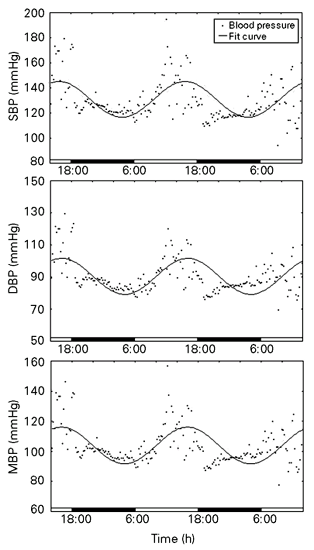Blood pressure (BP) profiles were monitored in nine free-ranging sloths (Bradypus variegatus) by coupling one common carotid artery to a BP telemetry transmitter. Animals moved freely in an isolated and temperature-controlled room (24ºC) with 12/12-h artificial light-dark cycles and behaviors were observed during resting, eating and moving. Systolic (SBP) and diastolic (DBP) blood pressures were sampled for 1 min every 15 min for 24 h. BP rhythm over 24 h was analyzed by the cosinor method and the mesor, amplitude, acrophase and percent rhythm were calculated. A total of 764 measurements were made in the light cycle and 721 in the dark cycle. Twenty-four-hour values (mean ± SD) were obtained for SBP (121 ± 22 mmHg), DBP (86 ± 17 mmHg), mean BP (MBP, 98 ± 18 mmHg) and heart rate (73 ± 16 bpm). The SBP, DBP and MBP were significantly higher (unpaired Student t-test) during the light period (125 ± 21, 88 ± 15 and 100 ± 17 mmHg, respectively) than during the dark period (120 ± 21, 85 ± 17 and 97 ± 17 mmHg, respectively) and the acrophase occurred between 16:00 and 17:45 h. This circadian variation is similar to that observed in cats, dogs and marmosets. The BP decreased during "behavioral sleep" (MBP down from 110 ± 19 to 90 ± 19 mmHg at 21:00 to 8:00 h). Both feeding and moving induced an increase in MBP (96 ± 17 to 119 ± 17 mmHg at 17:00 h and 97 ± 19 to 105 ± 12 mmHg at 15:00 h, respectively). The results show that conscious sloths present biphasic circadian fluctuations in BP levels, which are higher during the light period and are mainly synchronized with feeding.
Sloths; Bradypus; Circadian rhythm; Blood pressure



